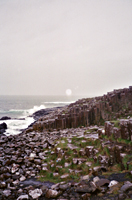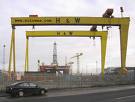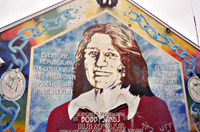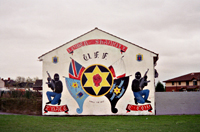







![]()
Day One
Twenty eight students and four members of staff travelled to Northern Ireland. The first major stop was at the Giant Causeway on the North Antrim coastline. The Giant's Causeway is a World Heritage site, National Nature Reserve and Northern Ireland 's premier tourist attraction.
Popular mythology attributes the creation of this world famous site to the Giant Finn MacCool who is believed to have built this remarkable pathway of stepping stones across the sea to Scotland so he could engage in battle with his rival giant Benandonner.
The geology shows that the Causeway was a result of intense volcanic activity that took place some 60 million years ago when molten rock poured out over the landscape to form deep pools of lava. The slow even cooling, and the contraction of the rock as it cooled, resulted in the formation of the many regular-sided columns of basalt that make up the Grand, Middle and Little Causeway.
Further up the coast we visited Dunluce Castle which sits on the edge of limestone cliffs and is connected to the mainland by an arched walkway.
Day Two
We travelled inland to Londonderry (also called Derry, also called the Walled City). As we travelled to the Walled City it was evident to see if a town en route was mainly unionist or nationalist. All the signs in Northern Ireland refer to the Walled city as Londonderry; when we went through a town that was nationalist they had painted out the London to leave the sign saying Derry. We had all been told this before we arrived in Northern Ireland and it was fascinating to be able to see it.
We had a guide who took us up onto the Walls and into the Bogside to show us the murals and give us the information of this area. Our guide was a nationalist and was actually involved in Bloody Sunday. He was a very passionate man and it was interesting to hear what he had experienced. The politically divided community in Belfast is clearly illustrated in the wall murals associated with each community. Northern Ireland contains arguably the most famous political murals.


Day Three
We had a tour of the Belfast city and the dock where the Titanic was built. One of the most famous landmarks of Belfast the two cranes Samson and Goliath. The two great yellow-painted gantry cranes have become icons of Belfast, dominating not just Queen's Island but the entire city skyline. The Harland and Wolff crane Goliath began work in 1969 and Samson in 1974. Now much beloved Belfast landmarks, their own future was assured in 2003 when they were scheduled for preservation.
We also visited Stormont, the parliament building of Northern Ireland - visit the Stormont website for more background information.
Our coach driver for our tour of East Belfast was a unionist; it was good to hear about the troubles from both perspectives.
We visited the peace wall that separates the Catholic neighbourhood of Lower Springfield Road from the Protestant area on Shankill Road. It is such a massive structure and it really brought home the conflict that has taken place over the years. We had a chance to get off the coach and read the messages of peace that had been written to the people of Northern Ireland and we were able to add our own messages. We also looked at the murals on both the Catholic side of the wall and the protestant side and our guide gave us lots of information about what the murals where depicting.
This brought our trip of Northern Ireland to an end. It was a wonderful experience for everyone involved. The students were able to experience another culture and learn first hand about the history of the beautiful place that is Northern Ireland.
Rebecca Winfield
Activities Department
